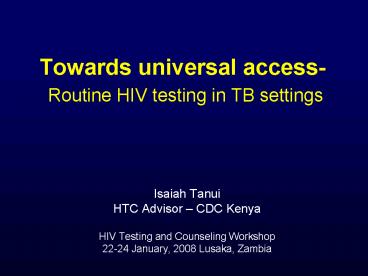Towards universal access Routine HIV testing in TB settings - PowerPoint PPT Presentation
1 / 17
Title:
Towards universal access Routine HIV testing in TB settings
Description:
Towards universal access- Routine HIV testing in TB settings. Isaiah Tanui ... Harmonization and standardization. Enhancing the role of health workers in CT ... – PowerPoint PPT presentation
Number of Views:34
Avg rating:3.0/5.0
Title: Towards universal access Routine HIV testing in TB settings
1
Towards universal access- Routine HIV testing in
TB settings
- Isaiah Tanui
- HTC Advisor CDC Kenya
- HIV Testing and Counseling Workshop
- 22-24 January, 2008 Lusaka, Zambia
2
Outline
- Background of TB in Kenya
- Implementing PITC in TB settings
- Benefits of PITC in TB settings
- Testing TB suspects
- Lessons learnt
- Challenges
- Conclusion
3
Tuberculosis in Kenya
- Kenya is a high TB burden country
- Near TB control in the early 1980s
- Rapid increase in the 1990s
- 11,625 in 1990 to 115,173 in 2006
- Major reason concurrent HIV epidemic
- TB-HIV collaborative activities initiated in 2004
- PITC is one of the tenets of TB-HIV collaborative
activities
4
Trend of TB notification
5
PITC guidelines in Kenya
- Beyond client initiated CT in health settings
- Increasing need for CT in health facilities
- Prevention
- Access to care
- Harmonization and standardization
- Enhancing the role of health workers in CT
- Stigma reduction among health workers
- CT as part of general health care services
6
Implementing PITC
7
Where PITC is provided
- Point of care (bed-side/clinic)
- Separate counseling and testing room
- Counseling (information) at POC and testing in
the Lab - Referral to VCT (rare)
- POC is currently popular. In future, testing in
the lab will be more sustainable
8
Personnel involved
- Attending clinician (doctor/CO)
- Ward/clinic nurse
- Laboratory technician
- Lay (or VCT) counselor (testers in KNH)
9
(No Transcript)
10
Achievements
- Improved data collection system (2005)
- HIV prevalence in TB patients known (52 in 2006)
- National target Universal access by 2010 ( 80
by 2008) - Increased access to comprehensive HIV/AIDS
services - Prevention
- Care
- Treatment
11
Key benefits of PITC in TB settings
- Making HIV testing routine in OPD
- Enhancing the role of health workers in CT
- Stigma reduction especially among health workers
- Supporting access to care/treatment
- Supporting HIV prevention
12
Going beyond PITC in TB settings
- PITC for TB suspects
- HIV (and TB) testing for family members of TB
patients - Expanded prevention interventions in TB settings
- Initiation of HIV/AIDS care and treatment
services in TB settings
13
Examples of CT for TB suspects
- (Uganda)
- Prevalence higher in patients with non-TB
diagnosis - All patients under evaluation for TB should have
an HIV test - HIV infected TB suspects reporting high risk
behavior should receive risk reduction counseling
(Srikantiah et al (Feb. 2007) - (Malawi)
- Chronic cough clinics are useful settings for
recruitment of patients for ART (Munthali L, et
al (Feb,2006) - (South Africa)
- VCT is critical to effective prevention and TB
facilities are the optimal venues for delivery of
these services - Providers need to be more sensitive to TB
patients because of the double stigma of TB and
HIV (Daftary A, et al, April 2007)
14
Lessons learnt
- Simple, clear national guidelines and training
materials required - Health worker driven PITC is effective and
sustainable - Involve leadership of health system at all levels
- Make testing routine and integrate into general
health system - Working data system is necessary
- Go beyond HIV testing
15
Challenges
- Human resources staff shortages
- Infrastructure inadequate space
- Leadership and coordination
- Referral mechanism weak
- Erratic supply of commodities
- Stigma among health care providers
- Wider societal issues (e.g. poverty in urban
slums)
16
Conclusion
- Universal access in TB is achievable
- Shift to routine testing
- Strengthen referral to care and treatment
- Incorporate HIV prevention into minimum package
17
Thank you































